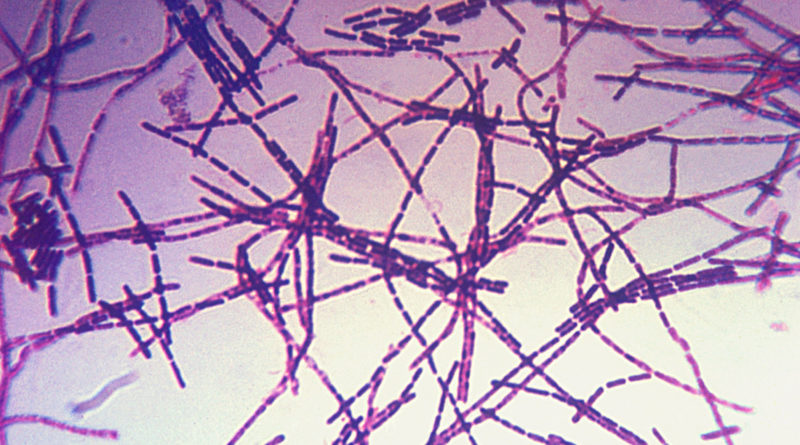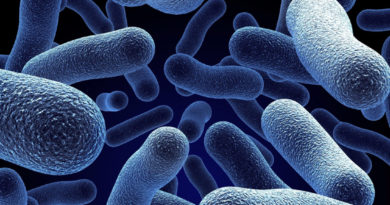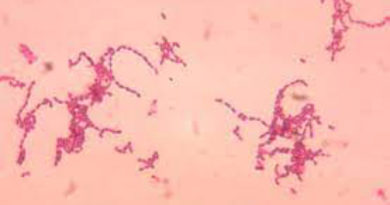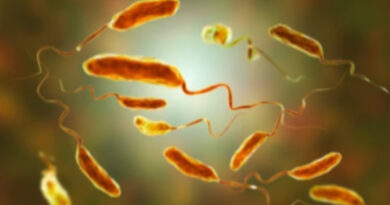Bacillus Anthracis
It was the first pathogenic bacterium to be observed under the microscope, the first communicable disease shown to be transmitted by inoculation of infected blood. It was the first bacillus to be isolated in pure culture and shown to possess spores and the first bacterium used for the preparation of an attenuated vaccine.
Morphology
The anthrax bacillus is one of the largest of pathogenic bacteria, measuring 3 – 10 micrometer x 1 – 1.6 micrometer. In tissues, it is found singly, in pairs or in short chains. The entire chain being surrounded by a capsule. Capsules are not formed under ordinary conditions of culture but only if the media contain added bicarbonate or are incubated under 10 – 25% CO2. If grown in media containing serum, albumin, charcoal or starch, capsule formation may occur in the absence of CO2.
The anthrax bacillus is gram positive and non acid fast. The spores do not stain by ordinary methods but can be stained differentially by special techniques. Unlike other members of genus bacilli, anthrax bacillus is nonmotile.
Cultural Characteristics
Anthrax bacillus is an aerobe, and a facultative anaerobe, with a temperature range for growth is 12 – 45 C (optimum 35 – 37 C). the optimum temperature for sporulation is 25 – 30 C. the good growth occurs on ordinary media.
On agar plates, irregular round colonies are formed, 2 – 3 mm in diameter, raised, dull, opaque, grayish white, with a frosted glass appearance.
Virulent capsulated strains form rough cultures, while avirulent or attenuated strains form smooth colonies.
A selective media (PLET medium), consisting of polymyxin, lysozyme, ethylene diamine tetra acetic acid (EDTA) and thallus acetate added to heart infusion agar, has been devised to isolate B. anthracis from a mixture containing other sporebearing bacilli.
Biochemical Reactions
Glucose, maltose and sucrose are fermented producing acid but no gas. Nitrates are reduced to nitrites. Catalase is formed.
Resistance
The vegetative bacilli can be easily destroyed at 60 C in 30 minutes.
The spores are highly resistant to physical and chemical agents. They have been isolated from naturally infected soil after as long as 60 years. They resist dry heat at 140 C for 1 – 3 hours and boiling for 10 minutes. They survive in 5% phenol for weeks.
4% potassium permanganate kills them in 15 minutes.
The anthrax bacillus is susceptible to sulphonamides, penicillin, erythromycin, streptomycin, tetracycline and chloramphenicol. Occasional strains resistant to penicillin have been met with.
Pathogenicity
In nature, anthrax is primarily a disease of cattle and sheep, and less often of horses and swine but experimentally most animals are susceptible to a greater one lesser degree. Frogs are resistant, while toads are very susceptible.
Following the subcutaneous inoculation of a culture into a guinea pig, the animal dies in 24 – 72 hours, showing a local, gelatinous, hemorrhagic edema at the site of inoculation.
Two virulence factors have been identified – the capsular polypeptide and the anthrax toxin, each of which is encoded by a separate plasmid.
The capsular polypeptide aids virulence by inhibiting phagocytosis. Loss of the plasmid (pX02) which controls capsule production leads to loss of virulence. This is how the live attenuated anthrax spore vaccine (Sterne strain) was obtained.
Treatment
Antibiotic therapy is effective in human cases but rarely succeeds in animals as therapy is not started sufficiently early. antibiotics have no effect on the toxin once it is formed. Penicillin and streptomycin are no longer used for treatment. They have been replaced by doxycycline and ciprofloxacin, which are effective in prophylaxis and treatment.
Reference: The Text Book Of Microbiology



